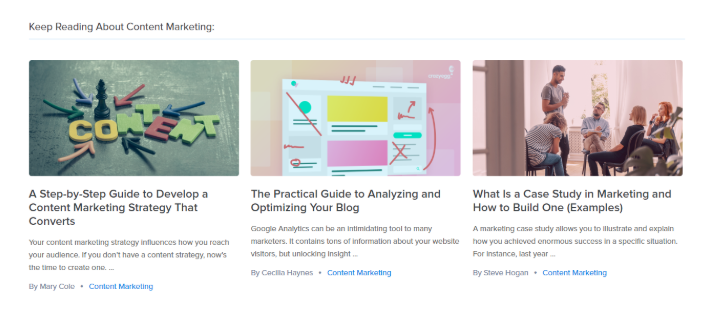The engagement rate on a website is becoming a major deal. Factors such as the bounce rate, organic click-through rate, and average page on time are indirect signals that impact your website’s search engine rankings.
Therefore, it is important to stay on top of them.
Moreover, even if these factors didn’t impact search rankings at all, they are still important for keeping your website visitors interested, engaged, and hooked to your website. A high engagement rate increases your site’s authority, while also giving you more chances of converting a random website visitor into a loyal fan and paying customer.
Here are 6 effective ways to increase user engagement on your website.
1. Improve the design of your website and declutter it
What’s the first thing a person would see after landing on your website?
Yes. The design of your website.
If it is too cluttered and confusing, the chances are that visitors would just quit your website right away. That would not only lead to a higher bounce rate, but it also sends a negative signal to Google and other search engines that your website might not be worth showing among the top search engine results.
Your website design should be simple, inviting, and user-friendly. Here are a few tips you should follow:
- Use a lot of white space.
- Use bigger, easily readable fonts
- Do not use colors or color combinations that are not pleasing to look
- Present your menu in a simple fashion. Make sure it is easily accessible even by non-technical users.
- Keep the layout of your website simple.
Here is a good example of a website that isn’t cluttered at all.
2. Simplify website navigation
Website navigation plays a key role in keeping the bounce rate low and the engagement rate high. If your website visitors cannot find the gateway to other web pages (navigation), they will most likely quit it without visiting other pages. That would increase the bounce rate, and you’d lose a potential customer.
Here are a few tips to help you improve your website navigation:
- Make sure all navigation elements are clickable links
- Showcase your main menu clearly at the top of the web page.
- Make your main menu floatable, so when a user scrolls down the page, the menu is still visible.
- Use familiar terms in the menu, e.g., Home, About Us, Contact Us, etc.
- Make sure all links redirect users to the right pages
- Add a search box alongside the main menu so the users can search for whatever they are looking for, instead of quitting your website.
- In the case of e-commerce stores, clearly define and divide different categories.
- Create a useful 404 page — not a generic one that isn’t useful at all — that features a search box for users and has all the links to important pages on the site.
3. Improve the loading speed of your website

Approximately 53 percent of visitors will abandon your website if it takes more than 3 seconds to load. That will have a significant adverse effect on the engagement rate of your site.
That’s why increasing the loading speed of your website should be one of your main priorities. Apart from increasing the engagement rate and your site’s credibility, faster loading speed will also have a positive effect on your site’s rankings in the SERPs.
You can use free tools, such as the SEO Site Checkup Toolbox and Google PageSpeed Insights, to find out how long it takes for your website to load. As there is always room for improvement in this area, here are a few steps you can take to increase your page speed even more:
- Minify CSS files
- Minify JS files
- Minimize redirects
- Optimize images that you use on your website
- Leverage browser caching
- Defer JavaScript loading
- Upgrade to a better hosting service
- Use a CDN
4. Create better content
Almost all website visitors are primarily interested in one thing: content.
Everybody on the internet is looking for some sort of information. If your website can provide them with the right content at the right time, you can significantly increase the engagement rate.
However, on the other hand, if your website content isn’t high quality, readers will quit your site right away without clicking on any other link.
As mentioned earlier, that will be bad for your site’s bounce rate as well as its ranking in the search engine results pages.
Here are a few tips to help you create great content and grab your readers’ attention:
- Choose an engaging and attention-grabbing headline. It is often the first part a reader will focus on, and it has to be captivating enough to hook them and encourage them to stay on the page.
- Start your blog post powerfully. Avoid generic statements. Instead, focus on interesting stats, data points, or questions. To grab their attention from the beginning, you can also directly address the main problem you’re tackling.
- Use images, videos, infographics, and other assets to keep things interesting for readers.
- Add as much exclusive information as you can to the article. Make sure it offers genuine value to the readers that they can’t find elsewhere on the web.
- Divide your text into shorter paragraphs, bullet points, numbered lists, and many subheadings. Nobody likes to read a huge wall of text.
5. Write longer pieces
Apart from creating high-quality, useful, and interesting content, you should also try creating longer pieces. Studies suggest that articles that are between 1,000 to 2,500 words perform better in terms of engagement.
For as long as your content is interesting and useful, the more words there are, the longer visitors will stay on your page reading. However, it is important to understand that this can easily become a double-edged sword.
You must not expand content just for the sake of it. Avoid fluff, filler content, and focus on adding genuine value. Make sure it is actionable, interesting, useful, and full of practical and easy-to-consume information.
6. Display related content
Sometimes, people do not click on another web page before they quit a website (and, hence, increase the bounce rate) because they can’t find any.
It is your job to make other web pages easily accessible by displaying them at strategic places on your website.
One good idea is to use a simple plugin that displays related pieces of content at the end of a web page. This encourages readers to click on a new link, read another article, and stay on your website.
Here is an example.
While you are at it, also make use of internal linking effectively. Spread links to other related articles throughout your web page wherever it makes sense. However, make sure that you are using descriptive anchor texts — instead of generic ones, such as click here or read this —to encourage more clicks.
One step at a time
There is no doubt about the importance of a high engagement rate. Follow these 6 tactics mentioned in this article to improve on that front.
You may not like the process. It may be tough to accept that your website design or content quality may not be as good as you thought, but the end result is always worth the effort.
Because there are many variables involved, we suggest taking things step by step. Instead of making wholesale changes, focus on just one element, fix it, test it, and then move forward with the next aspect of your website.
